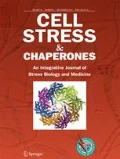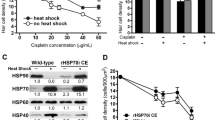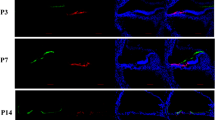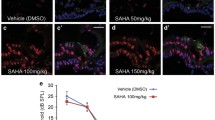Abstract
Sensory hair cells of the inner ear are sensitive to death from aging, noise trauma, and ototoxic drugs. Ototoxic drugs include the aminoglycoside antibiotics and the antineoplastic agent cisplatin. Exposure to aminoglycosides results in hair cell death that is mediated by specific apoptotic proteins, including c-Jun N-terminal kinase (JNK) and caspases. Induction of heat shock proteins (Hsps) can inhibit JNK- and caspase-dependent apoptosis in a variety of systems. We have previously shown that heat shock results in robust upregulation of Hsps in the hair cells of the adult mouse utricle in vitro. In addition, heat shock results in significant inhibition of both cisplatin- and aminoglycoside-induced hair cell death. In this system, Hsp70 is the most strongly induced Hsp, which is upregulated over 250-fold at the level of mRNA 2 h after heat shock. Hsp70 overexpression inhibits aminoglycoside-induced hair cell death in vitro. In this study, we utilized Hsp70-overexpressing mice to determine whether Hsp70 is protective in vivo. Both Hsp70-overexpressing mice and their wild-type littermates were treated with systemic kanamycin (700 mg/kg body weight) twice daily for 14 days. While kanamycin treatment resulted in significant hearing loss and hair cell death in wild-type mice, Hsp70-overexpressing mice were significantly protected against aminoglycoside-induced hearing loss and hair cell death. These data indicate that Hsp70 is protective against aminoglycoside-induced ototoxicity in vivo.




Similar content being viewed by others
References
Anckar J, Sistonen L (2007) Heat shock factor 1 as a coordinator of stress and developmental pathways. Adv Exp Med Biol 594:78–88. doi:10.1007/978-0-387-39975-1_8
Aran JM (1995) Current perspectives on inner ear toxicity. Otolaryngol Head Neck Surg 112:133–144. doi:10.1016/S0194-5998(95)70313-6
Beere HM, Wolf BB, Cain K, Mosser DD, Mahboubi A, Kuwana T, Tailor P, Morimoto RI, Cohen GM, Green DR (2000) Heat-shock protein 70 inhibits apoptosis by preventing recruitment of procaspase-9 to the Apaf-1 apoptosome. Nat Cell Biol 2:469–475. doi:10.1038/35019501
Chen YR, Tan TH (2000) The c-Jun N-terminal kinase pathway and apoptotic signaling (review). Int J Oncol 16:651–662
Cheng AG, Cunningham LL, Rubel EW (2002) Translocation of cytochrome c in hair cells of gentamicin-treated avian basilar papilla. Abstr Assoc Res Otolaryngol 25:35
Cheng AG, Cunningham LL, Rubel EW (2003) Hair cell death in the avian basilar papilla: characterization of the in vitro model and caspase activation. J Assoc Res Otolaryngol 4:91–105. doi:10.1007/s10162-002-3016-8
Chiu LL, Cunningham LL, Raible DW, Rubel EW, Ou HC (2008) Using the zebrafish lateral line to screen for ototoxicity. J Assoc Res Otolaryngol 9:178–190. doi:10.1007/s10162-008-0118-y
Cunningham LL (2006) The adult mouse utricle as an in vitro preparation for studies of ototoxic-drug-induced sensory hair cell death. Brain Res 1091:277–281. doi:10.1016/j.brainres.2006.01.128
Cunningham LL, Brandon CS (2006) Heat shock inhibits both aminoglycoside- and cisplatin-induced sensory hair cell death. J Assoc Res Otolaryngol 7:299–307. doi:10.1007/s10162-006-0043-x
Cunningham LL, Cheng AG, Rubel EW (2002) Caspase activation in hair cells of the mouse utricle exposed to neomycin. J Neurosci 22:8532–8540
Dechesne CJ, Kim HN, Nowak TS Jr, Wenthold RJ (1992) Expression of heat shock protein, HSP72, in the guinea pig and rat cochlea after hyperthermia: immunochemical and in situ hybridization analysis. Hear Res 59:195–204. doi:10.1016/0378-5955(92)90116-5
Desai SS, Zeh C, Lysakowski A (2005) Comparative morphology of rodent vestibular periphery. I. Saccular and utricular maculae. J Neurophysiol 93:251–266. doi:10.1152/jn.00746.2003
Earnshaw WC, Martins LM, Kaufmann SH (1999) Mammalian caspases: structure, activation, substrates, and functions during apoptosis. Ann Rev Biochem 68:383–424. doi:10.1146/annurev.biochem.68.1.383
Eshraghi AA, Wang J, Adil E, He J, Zine A, Bublik M, Bonny C, Puel JL, Balkany TJ, Van De Water TR (2007) Blocking c-Jun-N-terminal kinase signaling can prevent hearing loss induced by both electrode insertion trauma and neomycin ototoxicity. Hear Res 226:168–177. doi:10.1016/j.heares.2006.09.008
Forge A, Fradis M (1985) Structural abnormalities in the stria vascularis following chronic gentamicin treatment. Hear Res 20:233–244. doi:10.1016/0378-5955(85)90028-0
Forge A, Li L (2000) Apoptotic death of hair cells in mammalian vestibular sensory epithelia. Hear Res 139:97–115. doi:10.1016/S0378-5955(99)00177-X
Forge A, Schacht J (2000) Aminoglycoside antibiotics. Audiol Neurootol 5:3–22. doi:10.1159/000013861
Heydt JL, Cunningham LL, Rubel EW, Coltrera MD (2004) Round window gentamicin application: an inner ear hair cell damage protocol for the mouse. Hear Res 192:65–74
Hirakawa T, Rokutan K, Nikawa T, Kishi K (1996) Geranylgeranylacetone induces heat shock proteins in cultured guinea pig gastric mucosal cells and rat gastric mucosa. Gastroenterology 111:345–357. doi:10.1053/gast.1996.v111.pm8690199
Jaattela M, Wissing D, Kokholm K, Kallunki T, Egeblad M (1998) Hsp70 exerts its anti-apoptotic function downstream of caspase-3-like proteases. EMBO J 17:6124–6134. doi:10.1093/emboj/17.21.6124
Lang H, Liu C (1997) Apoptosis and hair cell degeneration in the vestibular sensory epithelia of the guinea pig following a gentamicin insult. Hear Res 111:177–184. doi:10.1016/S0378-5955(97)00098-1
Li L, Nevill G, Forge A (1995) Two modes of hair cell loss from the vestibular sensory epithelia of the guinea pig inner ear. J comp Neurol 355:405–417. doi:10.1002/cne.903550307
Mangiardi DA, McLaughlin-Williamson K, May KE, Messana EP, Mountain DC, Cotanche DA (2004) Progression of hair cell ejection and molecular markers of apoptosis in the avian cochlea following gentamicin treatment. J Comp Neurol 475:1–18. doi:10.1002/cne.20129
Marber MS, Mestril R, Chi SH, Sayen MR, Yellon DM, Dillmann WH (1995) Overexpression of the rat inducible 70-kD heat stress protein in a transgenic mouse increases the resistance of the heart to ischemic injury. J Clin Invest 95:1446–1456. doi:10.1172/JCI117815
Martindale JL, Holbrook NJ (2002) Cellular response to oxidative stress: signaling for suicide and survival. J Cell Physiol 192:1–15. doi:10.1002/jcp.10119
Matsui JI, Cotanche DA (2004) Sensory hair cell death and regeneration: two halves of the same equation. Curr Opin Otolaryngol Head Neck Surg 12:418–425. doi:10.1097/01.moo.0000136873.56878.56
Matsui JI, Ogilvie JM, Warchol ME (2002) Inhibition of caspases prevents ototoxic and ongoing hair cell death. J Neurosci 22:1218–1227
Matsui JI, Haque A, Huss D, Messana EP, Alosi JA, Roberson DW, Cotanche DA, Dickman JD, Warchol ME (2003) Caspase inhibitors promote vestibular hair cell survival and function after aminoglycoside treatment in vivo. J Neurosci 23:6111–6122
Matsui JI, Gale JE, Warchol ME (2004) Critical signaling events during the aminoglycoside-induced death of sensory hair cells in vitro. J Neurobiol 61:250–266. doi:10.1002/neu.20054
McArdle A, Dillmann WH, Mestril R, Faulkner JA, Jackson MJ (2004) Overexpression of HSP70 in mouse skeletal muscle protects against muscle damage and age-related muscle dysfunction. FASEB J 18:355–357
Mikuriya T, Sugahara K, Takemoto T, Tanaka K, Takeno K, Shimogori H, Nakai A, Yamashita H (2005) Geranylgeranylacetone, a heat shock protein inducer, prevents acoustic injury in the guinea pig. Brain Res 1065:107–114. doi:10.1016/j.brainres.2005.10.045
Miyake K, Tsukui T, Shinji Y, Shinoki K, Hiratsuka T, Nishigaki H, Futagami S, Wada K, Gudis K, Iwakiri K, Yamada N, Sakamoto C (2004) Teprenone, but not H2-receptor blocker or sucralfate, suppresses corpus Helicobacter pylori colonization and gastritis in humans: teprenone inhibition of H. pylori-induced interleukin-8 in MKN28 gastric epithelial cell lines. Helicobacter 9:130–137. doi:10.1111/j.1083-4389.2004.00209.x
Morimoto RI (2008) Proteotoxic stress and inducible chaperone networks in neurodegenerative disease and aging. Genes Dev 22:1427–1438. doi:10.1101/gad.1657108
Mosser DD, Caron AW, Bourget L, Denis-Larose C, Massie B (1997) Role of the human heat shock protein hsp70 in protection against stress-induced apoptosis. Mol Cell Biol 17:5317–5327
Nagasawa Y, Tatsuta M, Iishi H, Ishiguro S (1998) Prevention of gastric ulcer recurrence with tetraprenylacetone. Scand J of Gastroenterol 33:44–48. doi:10.1080/00365529850166194
Nakagawa T, Yamane H, Takayama M, Sunami K, Nakai Y (1998) Apoptosis of guinea pig cochlear hair cells following chronic aminoglycoside treatment. Eur Arch Otorhinolaryngol 255:127–131. doi:10.1007/s004050050027
Oda H, Miyake H, Iwata T, Kusumoto K, Rokutan K, Tashiro S (2002) Geranylgeranylacetone suppresses inflammatory responses and improves survival after massive hepatectomy in rats. J Gastrointest Surg 6:464–472 discussion 473 doi:10.1016/S1091-255X(01)00043-9
Ooie T, Takahashi N, Saikawa T, Nawata T, Arikawa M, Yamanaka K, Hara M, Shimada T, Sakata T (2001) Single oral dose of geranylgeranylacetone induces heat-shock protein 72 and renders protection against ischemia/reperfusion injury in rat heart. Circulation 104:1837–1843. doi:10.1161/hc3901.095771
Pirvola U, Xing-Qun L, Virkkala J, Saarma M, Murakata C, Camoratto AM, Walton KM, Ylikoski J (2000) Rescue of hearing, auditory hair cells, and neurons by CEP-1347/KT7515, an inhibitor of c-Jun N-terminal kinase activation. J Neurosci 20:43–50
Qian Y, Si JM, Wu JG, Chen SJ, Zhu YF, Sun KK, Deng YY, Chen K, Wang LJ, Liu WL (2007) [Effect of mucosal protective on the quality of gastric ulcer healing]. Zhejiang Da Xue Xue Bao Yi Xue Ban = J Zhejiang Univ 36:71–77
Sano H, Yoneda S, Iwase H, Itoh A, Hashimoto D, Okamoto M (2007) Effect of geranylgeranylacetone on gentamycin ototoxicity in rat cochlea culture. Auris Nasus Larynx 34:1–4. doi:10.1016/j.anl.2006.05.020
Sha SH, Taylor R, Forge A, Schacht J (2001) Differential vulnerability of basal and apical hair cells is based on intrinsic susceptibility to free radicals. Hear Res 155:1–8. doi:10.1016/S0378-5955(01)00224-6
Shirakabe H, Takemoto T, Kobayashi K, Ogoshi K, Kimura K, Nakamura K, Watanabe H (1995) Clinical evaluation of teprenone, a mucosal protective agent, in the treatment of patients with gastric ulcers: a nationwide, multicenter clinical study. Clin Ther 17:924–935. doi:10.1016/0149-2918(95)80070-0
Sone M, Hayashi H, Yamamoto H, Hoshino T, Mizushima T, Nakashima T (2005) Upregulation of HSP by geranylgeranylacetone protects the cochlear lateral wall from endotoxin-induced inflammation. Hear Res 204:140–146. doi:10.1016/j.heares.2005.01.012
Sugahara K, Inouye S, Izu H, Katoh Y, Katsuki K, Takemoto T, Shimogori H, Yamashita H, Nakai A (2003) Heat shock transcription factor HSF1 is required for survival of sensory hair cells against acoustic overexposure. Hear Res 182:88–96. doi:10.1016/S0378-5955(03)00180-1
Sugahara K, Rubel EW, Cunningham LL (2006) JNK signaling in neomycin-induced vestibular hair cell death. Hear Res 221:128–135. doi:10.1016/j.heares.2006.08.009
Takumida M, Anniko M (2005) Heat shock protein 70 delays gentamicin-induced vestibular hair cell death. Acta Otolaryngol 125:23–28
Taleb M, Brandon CS, Lee FS, Lomax MI, Dillmann WH, Cunningham LL (2008) Hsp70 inhibits aminoglycoside-induced hair cell death and is necessary for the protective effect of heat shock. J Assoc Res Otolaryngol 9(3):277–289
Taylor RR, Nevill G, Forge A (2008) Rapid hair cell loss: a mouse model for cochlear lesions. J Assoc Res Otolaryngol 9:44–64. doi:10.1007/s10162-007-0105-8
Tran Ba Huy P, Bernard P, Schacht J (1986) Kinetics of gentamicin uptake and release in the rat. Comparison of inner ear tissues and fluids with other organs. J Clin Invest 77:1492–1500. doi:10.1172/JCI112463
Trott A, West JD, Klaic L, Westerheide SD, Silverman RB, Morimoto RI, Morano KA (2008) Activation of heat shock and antioxidant responses by the natural product celastrol: transcriptional signatures of a thiol-targeted molecule. Mol Biol Cell 19:1104–1112. doi:10.1091/mbc.E07-10-1004
Tsuchiya D, Hong S, Matsumori Y, Shiina H, Kayama T, Swanson RA, Dillman WH, Liu J, Panter SS, Weinstein PR (2003) Overexpression of rat heat shock protein 70 is associated with reduction of early mitochondrial cytochrome C release and subsequent DNA fragmentation after permanent focal ischemia. J Cereb Blood Flow Metab 23:718–727. doi:10.1097/01.WCB.0000054756.97390.F7
Westerheide SD, Bosman JD, Mbadugha BN, Kawahara TL, Matsumoto G, Kim S, Gu W, Devlin JP, Silverman RB, Morimoto RI (2004) Celastrols as inducers of the heat shock response and cytoprotection. J Biol Chem 279:56053–56060. doi:10.1074/jbc.M409267200
Wu WJ, Sha SH, McLaren JD, Kawamoto K, Raphael Y, Schacht J (2001) Aminoglycoside ototoxicity in adult CBA, C57BL and BALB mice and the Sprague-Dawley rat. Hear Res 158:165–178. doi:10.1016/S0378-5955(01)00303-3
Ylikoski J, Xing-Qun L, Virkkala J, Pirvola U (2002) Blockade of c-Jun N-terminal kinase pathway attenuates gentamicin-induced cochlear and vestibular hair cell death. Hear Res 166:33–43. doi:10.1016/S0378-5955(01)00388-4
Yoshida N, Kristiansen A, Liberman MC (1999) Heat stress and protection from permanent acoustic injury in mice. J Neurosci 19:10116–10124
Zhang YQ, Sarge KD (2007) Celastrol inhibits polyglutamine aggregation and toxicity though induction of the heat shock response. J Mol Med 85:1421–1428. doi:10.1007/s00109-007-0251-9
Acknowledgments
The authors gratefully acknowledge the assistance of Dr. Hainan Lang and Dr. Richard Schmiedt in the initial setup and calibrations for the ABR recordings. This work was supported by NIH 5 R01 DC 007613, NIH/NCRR extramural research facilities construction (C06) grants C06 RR015455, and C06 RR14516 from the Extramural Research Facilities Program of the National Center for Research Resources.
Author information
Authors and Affiliations
Corresponding author
Rights and permissions
About this article
Cite this article
Taleb, M., Brandon, C.S., Lee, FS. et al. Hsp70 inhibits aminoglycoside-induced hearing loss and cochlear hair cell death. Cell Stress and Chaperones 14, 427–437 (2009). https://doi.org/10.1007/s12192-008-0097-2
Received:
Revised:
Accepted:
Published:
Issue Date:
DOI: https://doi.org/10.1007/s12192-008-0097-2




